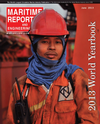
Page 10: of Maritime Reporter Magazine (June 2013)
Annual World Yearbook
Read this page in Pdf, Flash or Html5 edition of June 2013 Maritime Reporter Magazine
10 Maritime Reporter & Engineering News ? JUNE 2013 INSIGHT OFFSHORE BRAZIL Syndarma ? National Syndicate of Maritime Navigation CompaniesFounded on October 5, 1934, as the ofÞ cial representative of the Brazilian commercial maritime navigation, Syn-darma is comprised of two associations: ? ABEAM ? Brazilian Association of Maritime Support and ? ABAC ? Brazilian Coastal Ship Owners Association. In addition, it also lodges the compa-nies of the Port Support segment. Syn-darma is a proponent of the Brazilian maritime sectors, demonstrating to the public the importance of the employ-ment of Brazilian registered vessels in Brazilian waters as well as the necessity to expand the Brazilian merchant ß eet, the return of its position of importance to the country?s external commerce and its participation on the exploration of the O&G reserves on the Brazilian coast.Syndarma has 48 associated compa-nies in the coastal, oceangoing, offshore and port support segments, generating around 16,000 direct jobs (12,000 sea-farers and 4,000 administrative jobs).There are a total of 373 vessels under the Brazilian ß ag, separated in the fol- lowing classes: 139 tugboats on the port support (BHP>1.000) 175 offshore support vessels (TPB>100 and BHP>1.000) 59 ocean going vessels/coastal ships 21 container vessels/general cargo ships 23 bulk carriers/ocean barges nine chemicals/gas carriers six high seas pushers The Brazilian maritime legislation emphasizes that the maritime transport of cargo between ports in the national territory (coastal shipping) is reserved to Brazilian Navigation Companies in Portuguese ?Empresas Brasileiras de Navegação (EBN),? operating a vessel of Brazilian registry, which is common in most countries. Brazilian legislation concerning coast-al navigation is ß exible, allowing the employment of a chartered foreign ves-sel to an EBN to perform the domestic transport in case of the lack of a Brazil-ian ß agged vessel. This greatly helps in keeping with the rising demand for cargo ships and OSVs in Brazil.Brazilian Merchant Marine in Numbers - Source: ANTAQ General cargo: Bulk Liquid carriers: 109,573 thousand tons Offshore support: 71,352 thousand tons Non-offshore support: 38.222 thousand tons Solid bulk and projects: 17,057 thousand tons Containers: 811,000 TEU; 7.121 thousand tons Others: 4,894 thousand tons ABEAMAbeam was founded in April 1977 with a main objective to contribute to the development of the national offshore support sector for the oil and gas E&P along the Brazilian continental shelf and exclusive economic zone. The Offshore Support activities in Brazil had grown continuously from the mid 1970s until 1985, when it started to decline. By 2005 growth in the segment started anew, and the last eight years have shown a marked growth trend that is expected to continue until 2020 and beyond. ?The support from bioth Syndarma and Abeam are vital to reach solutions for the bottleneck that exists today in the Maritime and OSV segments in Brazil, they are fundamental links between the vessel and ship operators and the Brazil-ian Government,? said Douglas Moura, Operations Coordinator for SulNorte Shipping, regarding the importance of Syndarma and ABEAM in Brazil. ?Sub- jects that are relevant to the development of the market, such as lack of a special-ized workforce base, legislation that fa-vors the segment, along with systematic questions that impact company costs are the main focal points of Syndarma and Abeam meetings.? With the present policy of Brazil to increase O&G production along its East coast, where the Campos, Santos and Espirito Santo Basins are located and more recently with the tendering of Block along Brazil?s Equatorial Margin or North coast, there is now a demand a much larger ß eet of OSVs. Since the Brazilian O&G market is open to foreign companies, it is not only Petrobras that is expanding its activities. All players require OSVs for activities ranging from environmental research for Þ eld licensing, to equipment and work- force transfer to offshore units, to anchor handling, pipe laying, ROV, AUV and Diver operations. Abeam has 34 associ- ated companies prepared to operate most types of vessels employed in offshore support.Today, the OSV market in Brazil has a limited growth due to the fact that the last bidding round for offshore blocks was in 2007. But with the 11th round that took place recently, the market should see further expansion in the near future. The spot market for short duration ves-sel leasing is still heated, and there is a new demand for vessels specialized in support of environmental accidents, the OSRVs. This market will expand further as the 11th bidding round was a success and those acquiring Offshore Blocks will have a large (but still unde Þ ned) demand for OSVs for new exploration Offshore Brazil What You Need to Know to Operate Inside Syndarma and Abeam: Organizing Brazil?s Maritime and OSV Markets By Claudio PaschoaFor companies interested in operating in Brazil, it is important to understand the country. MR?s Editor in Rio breaks it down Bram PSV in Rio (Photo Bram Offshore) MR #6 (10-17).indd 10MR #6 (10-17).indd 105/31/2013 11:11:44 AM5/31/2013 11:11:44 AM

 9
9

 11
11
